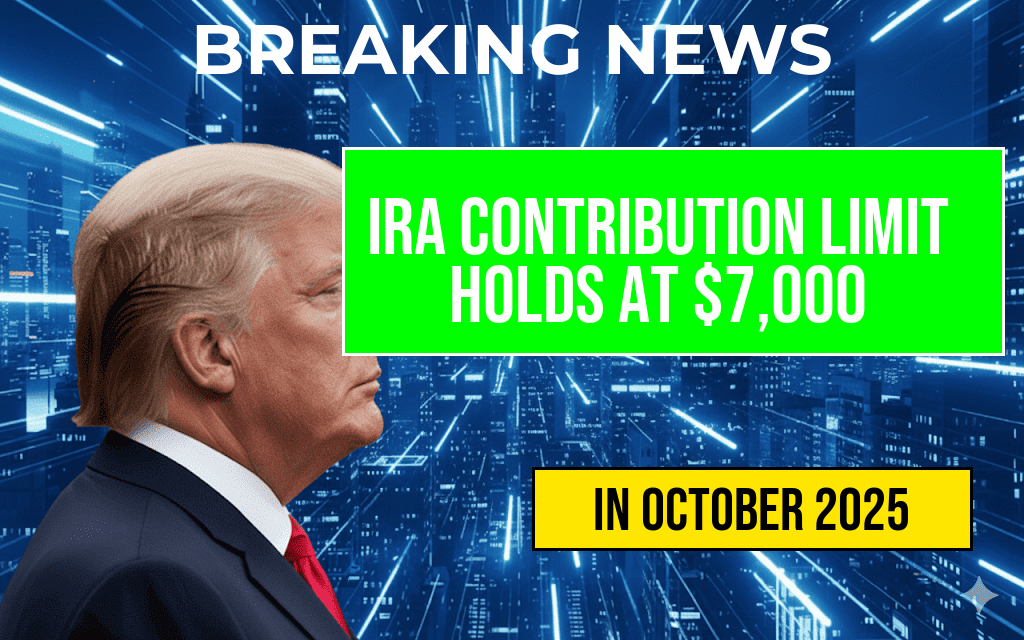The Internal Revenue Service (IRS) has announced that the contribution limit for both Traditional and Roth IRA accounts will remain unchanged at $7,000 for the upcoming tax year. This decision aligns with the inflation adjustment schedule, which often results in increases to retirement account limits, but in this case, the IRS has opted to keep the cap steady. The unchanged limit applies to individuals under age 50, while those 50 and older can continue making an additional catch-up contribution of $1,000, bringing their total to $8,000. This static limit influences millions of Americans planning their retirement savings strategies, especially amid fluctuating market conditions and evolving tax policies. Experts note that while the contribution ceiling remains static, other factors such as income thresholds and eligibility criteria continue to evolve, impacting how individuals can maximize their retirement investments.
Background on IRA Contribution Limits
The IRS periodically reviews contribution limits for retirement accounts to account for inflation and economic changes. Historically, these limits have increased gradually over the years, encouraging more Americans to save for retirement. The current figures, set for the 2024 tax year, reflect a decision not to adjust the cap despite inflationary pressures, signaling a cautious approach by policymakers. According to the Wikipedia entry on IRAs, the contribution limits are a critical aspect of retirement planning, influencing how much individuals can shelter from taxable income each year.
Implications for Retirement Planning
For Savers Under Age 50
- Maximum contribution remains at $7,000.
- Allows for consistent annual savings without the concern of increased caps.
- Encourages disciplined contributions, especially for those starting their retirement planning later in life.
For Catch-Up Contributions
- Individuals aged 50 and over can contribute an additional $1,000.
- This brings their total contribution limit to $8,000.
- Designed to help older workers bridge retirement savings gaps.
Factors Affecting Retirement Savings Strategies
| Age Group | IRA Contribution Limit | Catch-Up Contribution | Total Possible Contribution |
|---|---|---|---|
| Under 50 | $7,000 | N/A | $7,000 |
| 50 and Over | $7,000 | $1,000 | $8,000 |
While the contribution limits remain static, changes in income thresholds and phase-out ranges for tax deductions and credits can influence eligibility for certain IRA benefits. For example, high-income earners may face restrictions on deducting contributions to traditional IRAs or on contributing directly to Roth IRAs. These adjustments are part of ongoing efforts to balance retirement savings incentives with tax policy goals, as outlined in the Forbes retirement section.
Policy Context and Future Outlook
The IRS’s decision to hold the contribution limit steady reflects broader fiscal considerations. While inflation has increased over recent years, the agency appears to be cautious about raising the caps, possibly to maintain budget neutrality or control for potential tax revenue impacts. Some experts suggest that future adjustments may depend on inflation trends and legislative changes. The Biden administration has expressed interest in expanding retirement savings access, but concrete legislative proposals for increasing IRA limits have yet to gain traction. Observers keep a close eye on proposed tax reforms and their potential impact on individual retirement accounts, especially as the U.S. faces demographic shifts and economic uncertainties.
Additional Retirement Savings Options
Beyond IRAs, Americans have access to other retirement savings vehicles such as employer-sponsored 401(k) plans, which often have higher contribution limits. For 2024, the 401(k) contribution limit is set at $23,000 for those under 50, with a catch-up contribution of $7,500 for those 50 and older. Combining IRA contributions with employer-sponsored plans can maximize retirement savings potential, especially for individuals seeking to accelerate their savings as they approach retirement age. Experts recommend diversifying retirement strategies to account for tax implications, investment options, and personal financial goals.
Resources for Retirement Planning
Frequently Asked Questions
What is the current contribution limit for Traditional and Roth IRA accounts?
The contribution limit for both Traditional and Roth IRA accounts remains at $7,000 for the current year.
Has the IRA contribution limit changed this year?
No, the IRA contribution limit has remained at $7,000, continuing the same threshold from the previous year.
Who is eligible to contribute the maximum amount to an IRA?
Eligibility to contribute the maximum amount of $7,000 depends on income level and tax filing status. It is important to meet the IRS requirements to contribute the full amount.
Can I contribute the full $7,000 if I am over 50 years old?
Yes, if you are over 50 years old, you are eligible for catch-up contributions, allowing you to contribute an additional $1,000, making the total $8,000.
Are there any income restrictions that affect IRA contributions this year?
Income restrictions may limit or phase out your ability to contribute directly to a Roth IRA or deduct contributions to a Traditional IRA. Be sure to check the IRS guidelines for your specific income level.






